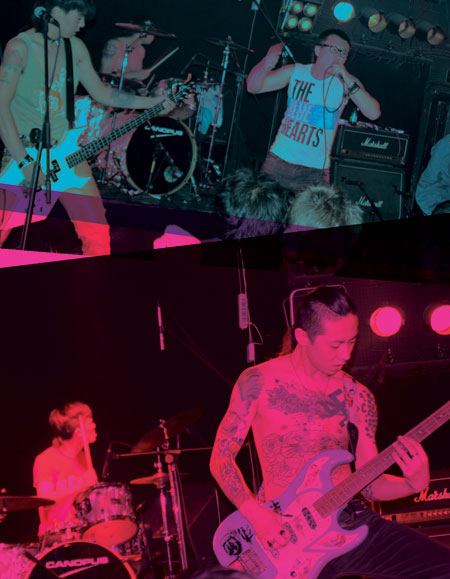beijing underground zhao dabao
I uxeta labrit nork jotzen du gaur? Azken urteotan taldeak eta musika munduan lanean dabilen jende kopurua ako hazi da. Garai batean ez bezala, Beijing-en zale asko mugitzen duen talde handirik ez dela geratzen konturatuko gara. Teknologia berriei esker talde berri eta ezberdin ugari ezagutzeko aukera dago, eskaintza askoz handiagoa da eta entzulegoa selektiboagoa bihurtu da taldeak aukeratzerako orduan. Zalegoa banatu egin da eta taldeen jarraitzaileak ez dira garai batetan bezain masiboak.
2012. urtearen haseran D-22 aretoa (ikus Cazhuxi-ren ilustrazioa), Beijing-ko gune underground garrantzitsuenetakoa, ateak itxi zituen. 2006. urtetik, Wudaokou unibertsitate zonaldean zegoen D-22 aretoa, rock talde underground ugariren gune bihurtu zen. besteak beste Joyside, Big Sharkof Houhai, Carsickars, Hedgehog eta The Gar, Gambler bezalako taldeek Txinako hiriburuan erreferentzia zen areto honen inguruan biltzen ziren. D-22 jabeek areto berria ireki dute, XP, eta musika eskena berriko talde gazte eta esperimentalei eskaini diete espazio berria. Noise eta musika esperimental zaleak bertan biltzen dira asteburuero, baina musika
estilo honek duen kutsu eta jarrera “artie”-ak uxatuta ziurrenik, ez du lortu garai batean D-22-k zuen giro kaletar herrikoia.
Beijing-ko eskena musikal underground-a hiriko erdigunera mugitu da eta oraintxe, saltsa guztia MAO Livehouse izeneko aretoan biltzen da. Aretoa XP baino handiagoa da eta bertan programatzen diren musika estiloak anitzagoak. Asteartean hasita eta igandera bitarte egunero daude metal, hardcore, punk, hip hop, rock, garage eta tarteka pop-a lantzen duten taldeen kontzertuak. Hiriko beste areto garrantsitsua Yu gong yishan da. Diseinuzko areto honetan jotzen dute normalki lehendabiziko aldiz Txinara etortze diren talde asko: Air, Mono, Andrew Bird, CocoRosie, Buzzcock, The Raveonettes, Silver Apples,… Beijing-ko musika aretorik handiena Star Live da, talde handi eta jaialdietarako erabiltzen den gunea.
Beijing-en, urtero, musika alternatiboari eskainitako 12 bat jaialdi handi antolatzen dira. Ezagunenak Midi Music Festival eta Strawberry Music Festival izenekoak. Jaialdi bakoitzean, gutxi gora behera, 20.000 pertsona biltzen da. Hiriak egun, musika talde, kontzertu, areto eta jaialdi gehiago ditu, baina bizi dugun gizartearen
isla dira. Guztia entzun eta ikusteko gaitasuna dugu, dena eskura dago, baina ez musikariak, ez entzulegoak ez dute aurrekoen indar, jarrera eta kemena. Eta 80. hamarkadan underground talde eta kantariak zirenak, pop izar bihurtu eta estadioetan antolatutako makro jaialdietan soilik jotzen dute, entzulegoak karaokea egin eta argi makiltxoekin koreografiak egin ditzan.
2012. urtearen haseran D-22 aretoa (ikus Cazhuxi-ren ilustrazioa), Beijing-ko gune underground garrantzitsuenetakoa, ateak itxi zituen. 2006. urtetik, Wudaokou unibertsitate zonaldean zegoen D-22 aretoa, rock talde underground ugariren gune bihurtu zen. besteak beste Joyside, Big Sharkof Houhai, Carsickars, Hedgehog eta The Gar, Gambler bezalako taldeek Txinako hiriburuan erreferentzia zen areto honen inguruan biltzen ziren. D-22 jabeek areto berria ireki dute, XP, eta musika eskena berriko talde gazte eta esperimentalei eskaini diete espazio berria. Noise eta musika esperimental zaleak bertan biltzen dira asteburuero, baina musika
estilo honek duen kutsu eta jarrera “artie”-ak uxatuta ziurrenik, ez du lortu garai batean D-22-k zuen giro kaletar herrikoia.
Beijing-ko eskena musikal underground-a hiriko erdigunera mugitu da eta oraintxe, saltsa guztia MAO Livehouse izeneko aretoan biltzen da. Aretoa XP baino handiagoa da eta bertan programatzen diren musika estiloak anitzagoak. Asteartean hasita eta igandera bitarte egunero daude metal, hardcore, punk, hip hop, rock, garage eta tarteka pop-a lantzen duten taldeen kontzertuak. Hiriko beste areto garrantsitsua Yu gong yishan da. Diseinuzko areto honetan jotzen dute normalki lehendabiziko aldiz Txinara etortze diren talde asko: Air, Mono, Andrew Bird, CocoRosie, Buzzcock, The Raveonettes, Silver Apples,… Beijing-ko musika aretorik handiena Star Live da, talde handi eta jaialdietarako erabiltzen den gunea.
Beijing-en, urtero, musika alternatiboari eskainitako 12 bat jaialdi handi antolatzen dira. Ezagunenak Midi Music Festival eta Strawberry Music Festival izenekoak. Jaialdi bakoitzean, gutxi gora behera, 20.000 pertsona biltzen da. Hiriak egun, musika talde, kontzertu, areto eta jaialdi gehiago ditu, baina bizi dugun gizartearen
isla dira. Guztia entzun eta ikusteko gaitasuna dugu, dena eskura dago, baina ez musikariak, ez entzulegoak ez dute aurrekoen indar, jarrera eta kemena. Eta 80. hamarkadan underground talde eta kantariak zirenak, pop izar bihurtu eta estadioetan antolatutako makro jaialdietan soilik jotzen dute, entzulegoak karaokea egin eta argi makiltxoekin koreografiak egin ditzan.



